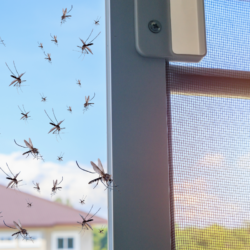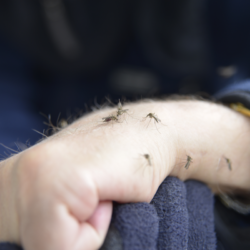Mosquito-borne viruses represent a significant threat to global public health. These pathogens, carried mainly by mosquito species such as Aedes aegypti and Culex pipiens, are responsible for serious diseases such as dengue fever, chikungunya, zika and Japanese encephalitis. The transmission of these viruses is facilitated by international travel, climate change and rapid urbanisation, increasing the vulnerability of human populations. Understanding transmission mechanisms and developing prevention and control strategies are essential to reducing the impact of these vector-borne diseases.
Chikungunya: Origin, Transmission and Symptoms
Dengue: A Global Public Health Challenge
Dengue fever is a viral disease transmitted by infected female Aedes aegypti and Aedes albopictus mosquitoes, which bite mainly during the day. Present in tropical and subtropical regions, it has spread rapidly, particularly in Europe and France.
In 2023, there were 2,019 imported cases of dengue fever and 45 native cases in mainland France. Between January and April 2024, 1,361 imported cases were reported, mainly from Martinique, Guadeloupe and French Guiana.
The first symptoms appear 4 to 10 days after the bite: high fever (40°C), headaches, muscle and eye pain, nausea, vomiting, lymphadenopathy and skin rash. Symptoms generally last 2 to 7 days. Serious complications, such as severe or haemorrhagic dengue fever, may occur, requiring immediate medical attention.
Diagnosis is based on blood tests to detect the virus or antibodies (IgG, IgM). Treatment is symptomatic, and non-steroidal anti-inflammatory drugs (NSAIDs) and aspirin are contraindicated because of the risk of haemorrhage.
Prevention is essential, including personal protection against bites and control of breeding sites. Vaccination is recommended for people living in endemic areas with a proven history of infection. Dengue, also known as “tropical flu”, is a global public health priority.
Zika virus: Implications for reproductive health
The Zika virus is transmitted to humans through the bites of Aedes aegypti and Aedes albopictus mosquitoes, as well as through sexual contact. In 2023, there were 9 imported cases of Zika in mainland France. Symptoms appear 3 to 12 days after the bite and include fever, headaches, aches and pains, conjunctivitis, oedema of the hands and feet, and skin rashes. Most cases are mild and heal within 2 to 7 days.
Diagnosis is by RT-PCR to detect viral RNA and serology for IgM and IgG antibodies. Treatment is symptomatic, mainly with paracetamol, and good hydration is essential. Non-steroidal anti-inflammatory drugs and aspirin are contraindicated.
Neurological complications, such as Guillain-Barré syndrome, and congenital malformations in newborns have been observed. Prevention is based on protection against mosquito bites and avoiding sexual transmission, especially for pregnant women.
The fight against Zika requires the destruction of breeding grounds and the use of individual protection such as long clothing and repellents. Pregnant women should adopt reinforced protective measures and avoid unprotected sex in high-risk areas.
Japanese encephalitis: a neuroinvasive disease
Japanese encephalitis is caused by a virus transmitted by Culex mosquitoes, which bite mainly at night. Found in South-East Asia and the Western Pacific, it mainly affects children. Most adults in endemic countries are naturally immune following childhood infection. Most infections are mild, but around 1 in 250 cases is severe, with symptoms such as :
- Stiff neck
- Disorientation
- Convulsions
- Paralysis, which can lead to death.
Neurological or psychiatric sequelae may also occur. The diagnosis is confirmed by biological analyses of cerebrospinal fluid or blood serum. There is no specific antiviral treatment; treatment is aimed at relieving symptoms.
Prevention is based on protection against mosquitoes and vaccination. The Japanese encephalitis virus is a flavivirus, similar to those of dengue fever, yellow fever and West Nile. Annual incidence varies, but it is estimated that there are around 68,000 clinical cases per year, with 13,600 to 20,400 deaths. Vaccination is recommended for travellers to endemic areas and for local populations at risk.





